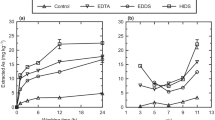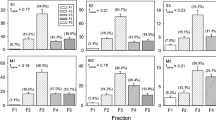Abstract
This study focused on evaluating the effectiveness of stabilizer/binding agents in immobilizing arsenic (As) in contaminated soil using both geochemical and geophysical monitoring methods. The effluent from the stabilizer/binding agent’s application and control columns was analyzed, and the status of the columns was monitored using electrical resistivity (ER) and induced polarization (IP) methods. As stabilizers/binder, acid mine drainage sludge (AMDS) and steel slag (SS) were used, which delayed As and Ca leaching time and significantly reduced As leaching amount. Determination coefficients for As and Fe leaching exhibited elevated values (control column, R2 = 0.955; AMDS column, R2 = 0.908; and SS column, R2 = 0.833). A discernible decline in the concentration of leached Fe was accompanied by a corresponding reduction in IP. The determination coefficients correlating IP and Fe leaching remained substantial (control column, R2 = 0.768; AMDS column, R2 = 0.807; and SS column, R2 = 0.818). Such IP measurements manifest as instrumental tools in monitoring and assessing the retention capacity of applied stabilizer/binding agents in As-affected soils, thereby furnishing crucial data for the enduring surveillance of stabilization/solidification locales. This research posits a swift and continuous monitoring method for solidification/stabilization locales in situ.






Similar content being viewed by others
Data availability
The datasets used during the current study are available from the corresponding author on reasonable request.
References
Ahn Y, Han M, Choi J (2020) Monitoring the mobility of heavy metals and risk assessment in mine-affected soils after stabilization. J Hazard Mater 400:123231
Ahn Y, Han M, Choi J (2022) Effect of electrode types and soil moisture on the application of electrical resistivity tomography and time-domain induced polarization for monitoring soil stabilization. Measurement 187:110220
Alegria FC, Martinho E, Almeida F (2009) Measuring soil contamination with the time domain induced polarization method using LabVIEW. Measurement 42:1082–1091
Astm D (2006) Standard practice for classification of soils for engineering purposes (unified soil classification system). ASTM Internasional, United States
Awa SH, Hadibarata T (2020) Removal of heavy metals in contaminated soil by phytoremediation mechanism: a review. Water Air Soil Pollut 231. https://doi.org/10.1007/s11270-020-4426-0
Bai Y, Yang T, Liang J, Qu J (2016) The role of biogenic Fe-Mn oxides formed in situ for arsenic oxidation and adsorption in aquatic ecosystems. Water Res 98:119–127
Banerjee K, Amy GL, Prevost M, Nour S, Jekel M, Gallagher PM, Blumenschein CD (2008) Kinetic and thermodynamic aspects of adsorption of arsenic onto granular ferric hydroxide (GFH). Water Res 42:3371–3378
Chen L, Du Y-J, Liu S-Y, ** F (2011) Evaluation of cement hydration properties of cement-stabilized lead-contaminated soils using electrical resistivity measurement. J Hazard, Toxic, Radio Waste 15:312–320
Clancy TM, Hayes KF, Raskin L (2013) Arsenic Waste management: a critical review of testing and disposal of arsenic-bearing solid wastes generated during arsenic removal from drinking water. Environ Sci Technol 47:10799–10812
Fan CC, Wang BM, Zhang TT (2018) Review on cement stabilization/solidification of municipal solid waste incineration fly ash. Adv Mater Sci Eng. https://doi.org/10.1155/2018/5120649
Khalid S, Shahid M, Niazi NK, Murtaza B, Bibi I, Dumat C (2017) A comparison of technologies for remediation of heavy metal contaminated soils. J Geochem Explor 182:247–268
Kumar H, Varma S (2021) A review on utilization of steel slag in hot mix asphalt. Int J Pavement Res Technol 14:232–242
Kumpiene J, Carabante I, Kasiuliene A, Austruy A, Mench M (2021) Long-term stability of arsenic in iron amended contaminated soil. Environ Pollut 269:116017
Lei J, Peng B, Min X, Liang Y, You Y, Chai L (2017) Modeling and optimization of lime-based stabilization in high alkaline arsenic-bearing sludges with a central composite design. J Environ Sci Health, Part A 52:449–458
Lévy L, Maurya P, Byrdina S, Vandemeulebrouck J, Sigmundsson F, Árnason K, Ricci T, Deldicque D, Roger M, Gibert B (2019) Electrical resistivity tomography and time-domain induced polarization field investigations of geothermal areas at Krafla, Iceland: comparison to borehole and laboratory frequency-domain electrical observations. Geophys J Int 218:1469–1489
Li J-S, Beiyuan J, Tsang DC, Wang L, Poon CS, Li X-D, Fendorf S (2017) Arsenic-containing soil from geogenic source in Hong Kong: leaching characteristics and stabilization/solidification. Chemosphere 182:31–39
Li EP, Yang T, Wang Q, Yu ZY, Tian SQ, Wang XX (2021) Long-term stability of arsenic calcium residue (ACR) treated with FeSO4. J Hazard Mater 420
Liu J, Zha F, Xu L, Kang B, Tan X, Deng Y, Yang C (2019) Mechanism of stabilized/solidified heavy metal contaminated soils with cement-fly ash based on electrical resistivity measurements. Measurement 141:85–94
Mansoor N, Slater L (2007) On the relationship between iron concentration and induced polarization in marsh soils. Geophysics 72:A1–A5
Mao D, Revil A, Hinton J (2016) Induced polarization response of porous media with metallic particles - part 4: detection of metallic and nonmetallic targets in time-domain induced polarization tomography. Geophysics 81:D359–D375
Masue Y, Loeppert RH, Kramer TA (2007) Arsenate and arsenite adsorption and desorption behavior on coprecipitated aluminum : iron hydroxides. Environ Sci Technol 41:837–842
Matsumoto S, Kasuga J, Taiki N, Makino T, Arao T (2015) Inhibition of arsenic accumulation in Japanese rice by the application of iron and silicate materials. CATENA 135:328–335
Misra V, Pandey SD (2005) Hazardous waste, impact on health and environment for development of better waste management strategies in future in India. Environ Int 31:417–431
Mohammad Eisa H, Vaezi I, Mahboubi Ardakani A (2020) Evaluation of solidification/stabilization in arsenic-contaminated soils using lime dust and cement kiln dust. Bull Eng Geol Env 79:1683–1692
Nazari AM, Radzinski R, Ghahreman A (2017) Review of arsenic metallurgy: treatment of arsenical minerals and the immobilization of arsenic. Hydrometallurgy 174:258–281
O’Connor J, Nguyen TBT, Honeyands T, Monaghan B, O’Dea D, Rinklebe J, Vinu A, Hoang SA, Singh G, Kirkham MB, Bolan N (2021) Production, characterisation, utilisation, and beneficial soil application of steel slag: a review. J Hazard Mater 419:126478
Ouhadi V, Yong R, Deiranlou M (2021) Enhancement of cement-based solidification/stabilization of a lead-contaminated smectite clay. J Hazard Mater 403:123969
Palma-Lara I, Martínez-Castillo M, Quintana-Pérez J, Arellano-Mendoza M, Tamay-Cach F, Valenzuela-Limón O, García-Montalvo E, Hernández-Zavala A (2020) Arsenic exposure: a public health problem leading to several cancers. Regul Toxicol Pharmacol 110:104539
Park J, Lee D, Kim H, Woo NC (2023) Effects of dry and heavy rainfall periods on arsenic species and behaviour in the aquatic environment adjacent a mining area in South Korea. J Hazard Mater 441:129968
Rahaman MS, Rahman MM, Mise N, Sikder MT, Ichihara G, Uddin MK, Kurasaki M, Ichihara S (2021) Environmental arsenic exposure and its contribution to human diseases, toxicity mechanism and management. Environ Pollut 289:117940
Ran H, Guo Z, Yi L, **ao X, Zhang L, Hu Z, Li C, Zhang Y (2021) Pollution characteristics and source identification of soil metal (loid) s at an abandoned arsenic-containing mine. China J Hazard Mater 413:125382
Saneiyan S, Ntarlagiannis D, Colwell F (2021) Complex conductivity signatures of microbial induced calcite precipitation, field and laboratory scales. Geophys J Int 224:1811–1824
Shen Z, ** F, O’Connor D, Hou D (2019) Solidification/stabilization for soil remediation: an old technology with new vitality. ACS Publications 53(20):11615–11617
Siddiqui SI, Chaudhry SA (2017) Iron oxide and its modified forms as an adsorbent for arsenic removal: a comprehensive recent advancement. Process Saf Environ 111:592–626
Sun RY, Hintelmann H, Liu Y, Li XH, Dimock B (2016) Two centuries of coral skeletons from the Northern South China Sea Record mercury emissions from modern Chinese wars. Environ Sci Technol 50:5481–5488
Suzuki S, Katoh M (2020) Estimation of potential arsenic leaching from its phases in excavated sedimentary and metamorphic rocks. Environ Geochem Hlth 42:407–418
Teixeira MC, Santos AC, Fernandes CS, Ng JC (2020) Arsenic contamination assessment in Brazil–past, present and future concerns: a historical and critical review. Sci Total Environ 730:138217
Troiano A, Isaia R, Tramparulo FDA, Di Giuseppe MG (2021) The Pisciarelli main fumarole mechanisms reconstructed by electrical resistivity and induced polarization imaging. Sci Rep 11(1):18639
Vanhala H, Soininen H (1995) Laboratory technique for measurement of spectral induced polarization response of soil samples. Geophys Prospect 43:655–676
Verbeeck M, Thiry Y, Smolders E (2020) Soil organic matter affects arsenic and antimony sorption in anaerobic soils. Environ Pollut 257:113566
Wilson SC, Lockwood PV, Ashley PM, Tighe M (2010) The chemistry and behaviour of antimony in the soil environment with comparisons to arsenic: a critical review. Environ Pollut 158:1169–1181
Wu C, Zou C, Wu T, Shen L, Zhou J, Tao C (2021) Experimental study on the detection of metal sulfide under seafloor environment using time domain induced polarization. Marine Geophys Res 42:17
Yong Y, Jianhang H, Yongkui L, Dapeng Z, Hua W (2022) A new method for simultaneous separation and solidification of arsenic from arsenic-bearing gypsum sludge using waste carbon cathodes. Sep Purif Technol 291:120656
Yoon Y, Park WK, Hwang T-M, Yoon DH, Yang WS, Kang J-W (2016) Comparative evaluation of magnetite–graphene oxide and magnetite-reduced graphene oxide composite for As (III) and As (V) removal. J Hazard Mater 304:196–204
Yu H-Y, Wang X, Li F, Li B, Liu C, Wang Q, Lei J (2017) Arsenic mobility and bioavailability in paddy soil under iron compound amendments at different growth stages of rice. Environ Pollut 224:136–147
Zha FS, Ji CJ, Xu L, Kang B, Yang CB, Chu CF (2019) Assessment of strength and leaching characteristics of heavy metal-contaminated soils solidified/stabilized by cement/fly ash. Environ Sci Pollut R 26:30206–30219
Zha F, Zhu F, Xu L, Kang B, Yang C, Zhang W, Zhang J, Liu Z (2021) Laboratory study of strength, leaching, and electrical resistivity characteristics of heavy-metal contaminated soil. Environ Earth Sci 80:1–11
Acknowledgements
The authors sincerely acknowledge the financial support from Korea Environment Industry&Technology Institute (2022002440002).
Funding
This research is supported by the Korea Environment Industry & Technology Institute (KEITI) through the Subsurface Environmental Pollution Risk Management Technology Development Project, funded by the Korea Ministry of Environment (MOE) (2022002440002).
Author information
Authors and Affiliations
Contributions
S. L.: Writing—original draft preparation, data curation, and investigation.
M. H.: Writing—reviewing and editing, methodology, and conceptualization.
Y. A.: Writing—reviewing and editing, methodology, and conceptualization.
B.-H. J.: Conceptualization and writing—reviewing and editing.
J. C.: Supervision, project administration, and funding acquisition.
Corresponding author
Ethics declarations
Ethics approval
The authors confirm that the manuscript has been read and approved by all authors.
Consent to participate
Not applicable.
Consent for publication
The authors consent to publish this research.
Competing interests
The authors declare no competing interests.
Additional information
Responsible Editor: Kitae Baek
Publisher's note
Springer Nature remains neutral with regard to jurisdictional claims in published maps and institutional affiliations.
Supplementary Information
Below is the link to the electronic supplementary material.
Rights and permissions
Springer Nature or its licensor (e.g. a society or other partner) holds exclusive rights to this article under a publishing agreement with the author(s) or other rightsholder(s); author self-archiving of the accepted manuscript version of this article is solely governed by the terms of such publishing agreement and applicable law.
About this article
Cite this article
Lee, SJ., Han, M.h., Ahn, YT. et al. Assessment of effectiveness in stabilization/solidification of arsenic-contaminated soil: long-term leaching test and geophysical measurement. Environ Sci Pollut Res 30, 120472–120482 (2023). https://doi.org/10.1007/s11356-023-30641-2
Received:
Accepted:
Published:
Issue Date:
DOI: https://doi.org/10.1007/s11356-023-30641-2




